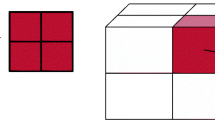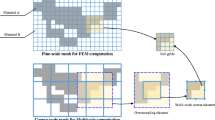Abstract
Topology optimization for large-scale problems continues to be a computational challenge. Several works exist in the literature to address this topic, and all make use of iterative solvers to handle the linear system arising from the finite element analysis (FEA). However, the preconditioners used in these works vary, and in many cases are notably suboptimal. A handful of works have already demonstrated the effectiveness of geometric multigrid (GMG) preconditioners in topology optimization. We provide a direct comparison of GMG preconditioners with algebraic multigrid (AMG) preconditioners. We demonstrate that AMG preconditioners offer improved robustness over GMG preconditioners as topologies evolve, albeit with a higher overhead cost. In 2D the gain from increased robustness more than offsets the overhead cost. However, in 3D the overhead becomes prohibitively large. We thus demonstrate the benefits of mixing geometric and algebraic methods to limit overhead cost while improving robustness, particularly in 3D.














Similar content being viewed by others
References
Aage N, Lazarov BS (2013) Parallel framework for topology optimization using the method of moving asymptotes. Struct Multidiscip Optim 47(4):493–505. https://doi.org/10.1007/s00158-012-0869-2
Aage N, Andreassen E, Lazarov BS (2015) Topology optimization using PETSc: An easy-to-use, fully parallel, open source topology optimization framework. Struct Multidiscip Optim 51(3):565–572. https://doi.org/10.1007/s00158-014-1157-0
Aage N, Andreassen E, Lazarov BS, Sigmund O (2017) Giga-voxel computational morphogenesis for structural design. Nature 550(7674):84–86. https://doi.org/10.1038/nature23911
Abel NH (1824) Mémoire sur les equations algébriques, où l’on démontre l’impossibilité de la résolution de l’équation générale du cinquième degré. In: Sylow L, Lie S (eds) Oeuvres complètes de Niels Henrik Abel. https://doi.org/10.1017/CBO9781139245807.004, https://www.cambridge.org/core/product/identifier/CBO9781139245807A010/type/book_part. Cambridge University Press, Cambridge, pp 28–33
Alexandersen J, Sigmund O, Aage N (2016) Large scale three-dimensional topology optimisation of heat sinks cooled by natural convection. Int J Heat Mass Transfer 100:876–891. https://doi.org/10.1016/j.ijheatmasstransfer.2016.05.013
Amir O, Aage N, Lazarov BS (2014) On multigrid-CG for efficient topology optimization. Struct Multidiscip Optim 49(5):815–829. https://doi.org/10.1007/s00158-013-1015-5
Arnoldi WE (1951) The principle of minimized iterations in the solution of the matrix eigenvalue problem. https://doi.org/10.2307/43633863
Balay S, Gropp WD, McInnes LC, Smith BF (1997) Efficient management of parallelism in object oriented numerical software libraries. In: Arge E, Bruaset AM, Langtangen HP (eds) Modern Software Tools in Scientific Computing. Birkhäuser Press, pp 163-202
Balay S, Abhyankar S, Adams MF, Brown J, Brune P, Buschelman K, Dalcin L, Eijkhout V, Gropp WD, Kaushik D, Knepley MG, McInnes LC, Rupp K, Smith BF, Zampini S, Zhang H, Zhang H (2016) PETSc Users Manual. Tech. Rep. ANL-95/11 - Revision 3.7, Argonne National Laboratory
Balay S, Abhyankar S, Adams MF, Brown J, Brune P, Buschelman K, Dalcin L, Dener A, Eijkhout V, Gropp WD, Karpeyev D, Kaushik D, Knepley MG, May DA, McInnes LC, Mills RT, Munson T, Rupp K, Sanan P, Smith BF, Zampini S, Zhang H, Zhang H (2019) PETSc Web page. http://www.mcs.anl.gov/petsc
Bendsøe MP, Sigmund O (2003) Topology Optimization: Theory, Methods and Applications. Engineering online library, Springer, http://books.google.com/books?id=NGmtmMhVe2sC
Benzi M (2002) Preconditioning techniques for large linear systems: A survey. J Comput Phys 182(2):418–477. https://doi.org/10.1006/JCPH.2002.7176. https://www.sciencedirect.com/science/article/pii/S0021999102971767?via
Benzi M, Tûma M (1999) A comparative study of sparse approximate inverse preconditioners. Appl Numer Math 30(2-3):305–340. https://doi.org/10.1016/S0168-9274(98)00118-4. https://www.sciencedirect.com/science/article/pii/S0168927498001184
Briggs WL, Henson VE (2000) Mccormick SF, A Multigrid Tutorial. Second Edition. Society for Industrial and Applied Mathematics. https://doi.org/10.1137/1.9780898719505
Bruns TE, Tortorelli DA (2001) Topology optimization of non-linear elastic structures and compliant mechanisms. Comput Methods Appl Mech Eng 190(26–27):3443–3459. https://doi.org/10.1016/S0045-7825(00)00278-4. http://www.sciencedirect.com/science/article/pii/S0045782500002784
Davidson ER (1975) The iterative calculation of a few of the lowest eigenvalues and corresponding eigenvectors of large real-symmetric matrices. J Comput Phys 17(1):87–94. https://doi.org/10.1016/0021-9991(75)90065-0
Davis TA (2006) Direct methods for sparse linear systems. Society for Industrial and Applied Mathematics
Falgout RD, Yang UM (2002) Hypre: A library of high performance preconditioners. In: Proceedings of the international conference on computational science-part III. https://doi.org/10.1007/3-540-47789-6_66. Springer, Berlin, pp 632–641
Ferrari F, Sigmund O (2019) Revisiting topology optimization with buckling constraints. Struct Multidiscip Optim 59(5):1401–1415. https://doi.org/10.1007/s00158-019-02253-3
G Sleijpen GL, Van der Vorst HA (1996) A Jacobi-Davidson iteration method for linear eigenvalue problems. SIAM Journal on Matrix Analysis and Applications 17(2):401–425. https://doi.org/10.1137/S0895479894270427
Gao X, Ma H (2015) Topology optimization of continuum structures under buckling constraints. Comput Struct 157:142–152. https://doi.org/10.1016/J.COMPSTRUC.2015.05.020. https://www.sciencedirect.com/science/article/pii/S0045794915001662
Gravesen J, Evgrafov A, Nguyen DM (2011) On the sensitivities of multiple eigenvalues. Struct Multidiscip Optim 44(4):583–587. https://doi.org/10.1007/s00158-011-0644-9
Hestenes MR, Stiefel E (1952) Methods of conjugate gradients for solving linear systems. J Res Natl Bur Stand 49(6):409–436
Jang IG, Kim IY (2010) Application of design space optimization to bone remodeling simulation of trabecular architecture in human proximal femur for higher computational efficiency. Finite Elements in Analysis and Design 46(4):311–319. https://doi.org/10.1016/j.finel.2009.11.003. http://www.sciencedirect.com/science/article/pii/S0168874X09001553
Kennedy G (2015) Large-scale multi-material topology optimization for additive manufacturing. In: 56th AIAA/ASCE/AHS/ASC structures, structural dynamics, and materials conference american institute of aeronautics and astronautics, Reston, Virginia. https://doi.org/10.2514/6.2015-1799
Kim IY, Kwak BM (2002) Design space optimization using a numerical design continuation method. Int J Numer Methods Eng 53(8):1979–2002. https://doi.org/10.1002/nme.369
Kim YY, Yoon GH (2000) Multi-resolution multi-scale topology optimization — a new paradigm. International Journal of Solids and Structures 37(39):5529–5559. https://doi.org/10.1016/S0020-7683(99)00251-6https://www.sciencedirect.com/science/article/pii/S0020768399002516
Knyazev AV (2001) Toward the optimal preconditioned eigensolver: locally optimal block preconditioned conjugate gradient method. SIAM J Sci Comput 23(2):517–541. https://doi.org/10.1137/S1064827500366124
Liao Z, Zhang Y, Wang Y, Li W (2019) A triple acceleration method for topology optimization. Struct Multidiscip Optim 60(2):727–744. https://doi.org/10.1007/s00158-019-02234-6
Liu K, Tovar A (2014) An efficient 3D topology optimization code written in Matlab. Struct Multidiscip Optim 50(6):1175–1196. https://doi.org/10.1007/s00158-014-1107-x
Mahdavi A, Balaji R, Frecker M, Mockensturm EM (2006) Topology optimization of 2D continua for minimum compliance using parallel computing. Struct Multidiscip Optim 32(2):121–132. https://doi.org/10.1007/s00158-006-0006-1
Morgan RB, Scott DS (1986) Generalizations of davidson’s method for computing eigenvalues of sparse symmetric matrices. SIAM J Sci Stat Comput 7(3):817–825. https://doi.org/10.1137/0907054
Nguyen TH, Paulino GH, Song J, Le CH (2010) A computational paradigm for multiresolution topology optimization (MTOP). Struct Multidiscip Optim 41(4):525–539. https://doi.org/10.1007/s00158-009-0443-8
Olson LN, Schroder JB (2018) {PyAMG}: Algebraic Multigrid Solvers in {Python} v4.0. https://github.com/pyamg/pyamg
Parks ML, De Sturler E, Mackey G, Johnson DD, Maiti S (2006) Recycling Krylov subspaces for sequences of linear systems. SIAM J Sci Comput 28(5):1651–1674. https://doi.org/10.1137/040607277
Ruge JW, Stüben K (1987) 4. Algebraic Multigrid. In: Multigrid methods, society for industrial and applied mathematics, pp 73–130. https://doi.org/10.1137/1.9781611971057.ch4
Saad Y (1993) A flexible Inner-Outer preconditioned GMRES algorithm. SIAM J Sci Comput 14(2):461–469. https://doi.org/10.1137/0914028
Saad Y (2003) Iterative Methods for Sparse Linear Systems. Society for Industrial and Applied Mathematics. https://doi.org/10.1137/1.9780898718003
Saad Y, Schultz MH (1986) GMRES: A generalized minimal residual algorithm for solving nonsymmetric linear systems. SIAM J Sci Stat Comput 7(3):856–869. https://doi.org/10.1137/0907058
Seyranian AP, Lund E, Olhoff N (1994) Multiple eigenvalues in structural optimization problems. Struct Optim 8(4):207–227. https://doi.org/10.1007/BF01742705
Sigmund O, Torquato S (1997) Design of materials with extreme thermal expansion using a three-phase topology optimization method. J Mech Phys Solids 45(6):1037–1067. https://doi.org/10.1016/S0022-5096(96)00114-7. https://www.sciencedirect.com/science/article/pii/S0022509696001147
Sleijpen GLG, Booten AGL, Fokkema DR, Van Der Vorst HA (1996) Jacobi-Davidson Type methods for generalized eigenproblems and polynomial eigenproblems. BIT Numerical Mathematics 3(November 1995):595–633. https://doi.org/10.1007/BF01731936
Svanberg K (1987) The method of moving asymptotes-a new method for structural optimization. Int J Numer Methods Eng 24(2):359–373. https://doi.org/10.1002/nme.1620240207
Talischi C, Paulino G, Pereira A, Menezes IM (2012) Polytop: a Matlab implementation of a general topology optimization framework using unstructured polygonal finite element meshes. Struct Multidiscip Optim 45(3):329–357. https://doi.org/10.1007/s00158-011-0696-x
Thomsen CR, Wang F, Sigmund O (2018) Buckling strength topology optimization of 2D periodic materials based on linearized bifurcation analysis. Comput Methods Appl Mech Eng 339:115–136. https://doi.org/10.1016/J.CMA.2018.04.031. https://www.sciencedirect.com/science/article/pii/S004578251830210X
Torii AJ, Faria JR (2017) Structural optimization considering smallest magnitude eigenvalues: a smooth approximation. J Braz Soc Mech Sci Eng 39(5):1745–1754. https://doi.org/10.1007/s40430-016-0583-x
Vaněk P, Mandel J, Brezina M (1996) Algebraic multigrid by smoothed aggregation for second and fourth order elliptic problems. Computing 56(3):179–196. https://doi.org/10.1007/BF02238511
Wang S, Ed Sturler, Paulino GH (2007) Large-scale topology optimization using preconditioned Krylov subspace methods with recycling. Int J Numer Methods Eng 69(12):2441–2468. https://doi.org/10.1002/nme.1798
Acknowledgments
The authors would like to extend their gratitude to Professor Luke Olson, UIUC Computer Science, for insightful discussions on algebraic multigrid.
Funding
This work received financial support from the National Science Foundation through awards 1435920 and 1753249.
Author information
Authors and Affiliations
Corresponding author
Ethics declarations
Conflict of interest
The authors declare that they have no conflict of interest.
Additional information
Responsible Editor: Ole Sigmund
Publisher’s note
Springer Nature remains neutral with regard to jurisdictional claims in published maps and institutional affiliations.
Replication of results
The code for this paper is available at https://github.com/darinpeetz/PyOpt and https://github.com/darinpeetz/TopOpt3D.
Appendix. Large-scale 3D cantilever beam
Appendix. Large-scale 3D cantilever beam
Here we describe the application of our proposed hybrid GMG-AMG preconditioner to the 3D cantilever problem at a larger scale (512 × 256 × 256 element mesh, approximately 100e6 dofs). This time we only perform 16 optimization iterations for each penalty increment to improve runtime, but the penalty is still increased in increments of 0.25 to a final value of 4. The filter radius is again set to 1.5 times the element dimension, meaning that the physical dimension of the filter radius is reduced by a factor of 2.67. The final result is shown in Fig. 15.
In Fig. 16 we show the performance of using the hybrid preconditioner for this problem. We restrict the coarse grid size to be less than 1000 dofs, corresponding to 7 levels in the geometric hierarchy, and we apply weighted point-block Jacobi as the smoother. It is important to note that in this case, the number of iterations to convergence remains substantially lower than in the smaller problem, never reaching even 100 iterations in a single optimization step. As a result, the hybrid scheme never converts levels of the multigrid preconditioner from geometric to algebraic coarsening. This means that 7 geometric levels are used through the entire simulation, with one small algebraic level at the end for ease of implementation.
It could be argued that this is an indication that AMG is not needed in larger scale problems; however, an important observation arises upon closer inspection of the optimized structures. Figure 17 shows the structure that develops along one edge of the domain for both the smaller and larger 3D problem and Fig. 18 shows the difference in the structures along the rear support. Note that in the small case, many more small structural elements develop in close proximity to each other in both of these regions. It is exactly these types of elements that cause difficulty for the GMG preconditioner, but they do not develop in the larger problem. Instead, these numerous structural elements are replaced with a single smooth feature that can only be captured on the higher-fidelity design space. As it is impossible to predict a priori what type of structure will develop from a given loading condition and mesh resolution this motivates the use of our hybrid preconditioner, which only applies algebraic coarsening as necessary. In the smaller problem the algebraic coarsening improves performance when geometric coarsening struggles, but in the larger problem the cheaper geometric strategy is used. In either case there is no need for the user to specify a fixed number of algebraic or geometric levels in the multigrid hierarchy.
Rights and permissions
About this article
Cite this article
Peetz, D., Elbanna, A. On the use of multigrid preconditioners for topology optimization. Struct Multidisc Optim 63, 835–853 (2021). https://doi.org/10.1007/s00158-020-02750-w
Received:
Revised:
Accepted:
Published:
Issue Date:
DOI: https://doi.org/10.1007/s00158-020-02750-w








